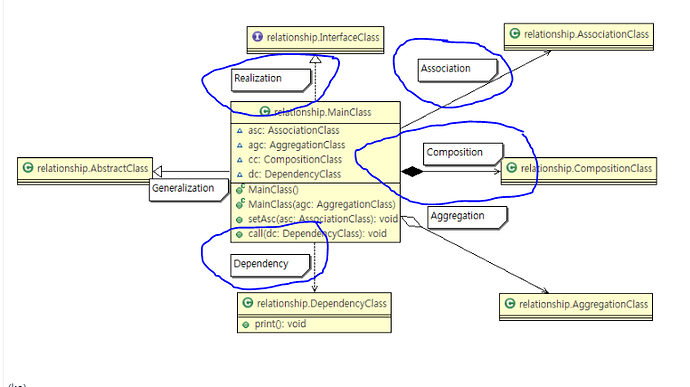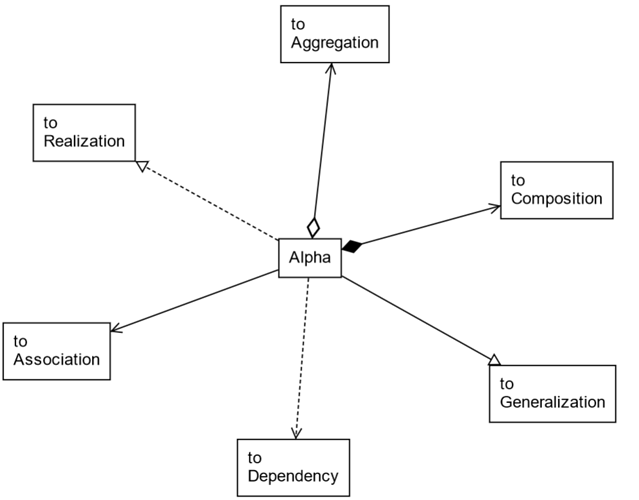The following sample:
<!DOCTYPE html>
<html>
<head>
<title>Various Kinds of UML Relationships</title>
<!-- Copyright 1998-2023 by Northwoods Software Corporation. -->
</head>
<body>
<div id="myDiagramDiv" style="border: solid 1px black; width:100%; height:500px"></div>
<textarea id="mySavedModel" style="width:100%;height:300px"></textarea>
<script src="https://unpkg.com/gojs"></script>
<script id="code">
const $ = go.GraphObject.make;
const myDiagram =
new go.Diagram("myDiagramDiv",
{
layout: $(go.ForceDirectedLayout),
"undoManager.isEnabled": true,
"ModelChanged": e => { // just for demonstration purposes,
if (e.isTransactionFinished) { // show the model data in the page's TextArea
document.getElementById("mySavedModel").textContent = e.model.toJson();
}
}
});
myDiagram.nodeTemplate =
$(go.Node, "Auto",
$(go.Shape, { fill: "white" }),
$(go.TextBlock, { margin: 8 },
new go.Binding("text"))
);
myDiagram.linkTemplateMap.add("Generalization",
$(go.Link,
$(go.Shape),
$(go.Shape, { toArrow: "Triangle", fill: "white" })
));
myDiagram.linkTemplateMap.add("Realization",
$(go.Link,
$(go.Shape, { strokeDashArray: [3, 2] }),
$(go.Shape, { toArrow: "Triangle", fill: "white" })
));
myDiagram.linkTemplateMap.add("Association",
$(go.Link,
$(go.Shape),
$(go.Shape, { toArrow: "OpenTriangle" })
));
myDiagram.linkTemplateMap.add("Composition",
$(go.Link,
$(go.Shape),
$(go.Shape, { fromArrow: "StretchedDiamond", scale: 1.5 }),
$(go.Shape, { toArrow: "OpenTriangle" })
));
myDiagram.linkTemplateMap.add("Aggregation",
$(go.Link,
$(go.Shape),
$(go.Shape, { fromArrow: "StretchedDiamond", fill: "white", scale: 1.5 }),
$(go.Shape, { toArrow: "OpenTriangle" })
));
myDiagram.linkTemplateMap.add("Dependency",
$(go.Link,
$(go.Shape, { strokeDashArray: [3, 2] }),
$(go.Shape, { toArrow: "OpenTriangle" })
));
myDiagram.model = new go.GraphLinksModel(
[
{ key: 1, text: "Alpha" },
{ key: 2, text: "to\nGeneralization" },
{ key: 3, text: "to\nRealization" },
{ key: 4, text: "to\nAssociation" },
{ key: 5, text: "to\nComposition" },
{ key: 6, text: "to\nAggregation" },
{ key: 7, text: "to\nDependency" },
],
[
{ from: 1, to: 2, category: "Generalization" },
{ from: 1, to: 3, category: "Realization" },
{ from: 1, to: 4, category: "Association" },
{ from: 1, to: 5, category: "Composition" },
{ from: 1, to: 6, category: "Aggregation" },
{ from: 1, to: 7, category: "Dependency" },
]);
</script>
</body>
</html>
produces:
You can fiddle with the details of each kind of link template if you would like to adjust the appearances to suit your tastes.
Note that I didn’t bother with any fancy node templates, since those are independent of the link templates. Presumably you have adapted the UML class node template from the sample.

